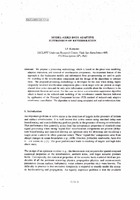| dc.contributor.author | Kirsteins, Ivars P. | |
| dc.date.accessioned | 2018-10-11T14:05:39Z | |
| dc.date.available | 2018-10-11T14:05:39Z | |
| dc.date.issued | 1993/08 | |
| dc.identifier | 797 | |
| dc.identifier.govdoc | CP-42/1 | |
| dc.identifier.uri | http://hdl.handle.net/20.500.12489/131 | |
| dc.description.abstract | We propose a processing methodology which is based on the piece-wise modeling, adaptive estimation, and removal of reverberation components. An important feature of this approach is that backscatter models and information from pre-processing are used to guide the modeling of the reverberation components and the design of the algorithms to estimate them. The proposed processing methodology is developed for the case when strong, highly temporally localized reverberation components plus a weak target echo are present in single channel time series data and the only prior information available about the reverberator is the approximate location and extent. For this case we derive a reverberation suppression algorithm which is based on the reduced-rank modeling of the reverberator transfer function followed by application of the Principal Component Inverse (PCI) method of reduced-rank adaptive interference cancellation. The algorithm is tested using simulated and real reverberation data. | |
| dc.format | 12 p. : ill., 7 fig. ; digital, PDF file | |
| dc.language | English | |
| dc.publisher | NATO. SACLANTCEN | |
| dc.source | In: Low frequency active sonar (SACLANTCEN Conference Proceedings CP-42), vol. 1, 1993, pp. C/11-1 - C/11-12. | |
| dc.subject | Acoustic reverberation | |
| dc.subject | Active sonar | |
| dc.subject | Signal processing | |
| dc.subject | Sonar mathematical models | |
| dc.subject | Reverberation suppression | |
| dc.title | Model-aided data adaptive suppression of reverberation | |
| dc.type | Papers and Articles | |
| dc.type | Conference Proceedings (CP) | |
